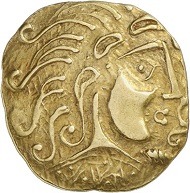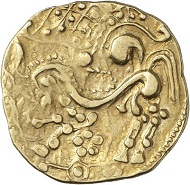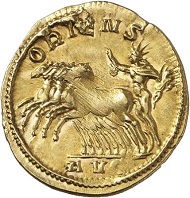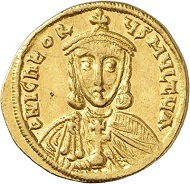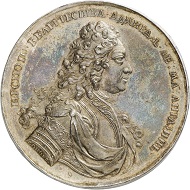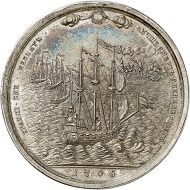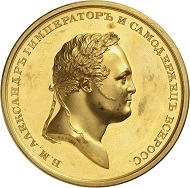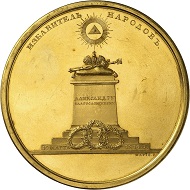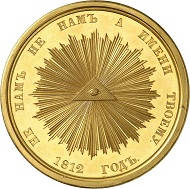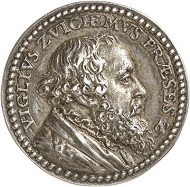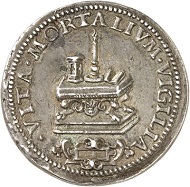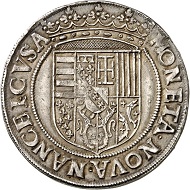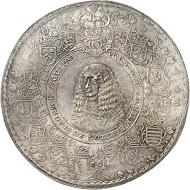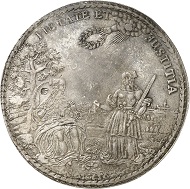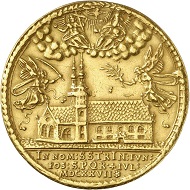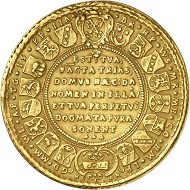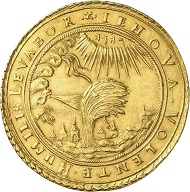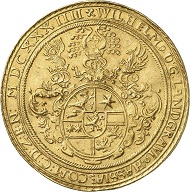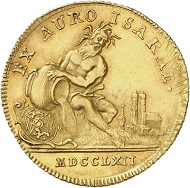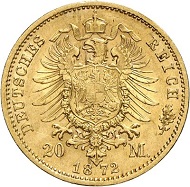20-06-2016 – 22-06-2016
Auction 277-279
220,000 euros for golden willow tree striking at Künker
There were more than 270 bidders on the floor during the three auctions held by auction house Künker from June 21-23, 2016. And 1,800 bidders sent in their bids. This strong interest propelled the overall estimate for about 3,000 lots from 7 million euros to 9.2 million euros. In the course of the auctions, the golden willow tree striking of William V of Hesse-Kassel in the weight of 10 ducats realized 220,000 euros. But also Russian coins and medals were awarded impressive results in the six digit region.
Auction 277: Coins from antiquity / Russian coins and medals
About one third of the overall revenue was achieved by the 575 lots of the first day – 1.3 million euros for ancient coins, and 1.7 million euros for 275 Russian coins and medals. Exceedingly rare specimens and show pieces were on offer.
Lot 3: PARISII (Celts). Gold stater, around 60 BC. Very rare. Good very fine. Estimate: 20,000 euros. Hammer price: 23,000 euros.
Among the Greek, Roman, and Byzantine coins, which opened the auction, many exceeded their estimates, even though already appraised in the five digit region. Here are two examples: a Parisii stater (20,000 / 23,000 euros) and an early Hellenistic gold stater from Tarentum (40,000 /46,000 euro).
Lot 146: POSTUMUS, 260-268. Aureus, 261, Cologne. Extremely rare. Good very fine / Extremely fine. Estimate: 20,000 euros. Hammer price: 38,000 euros.
Furthermore noteworthy are an extremely rare aureus of Postumus (20,000 / 38,000 euros) and a solidus of Constantius II, displaying an adventus scene, from the Trau collection (30,000 / 36,000 euros).
Especially the late Roman and Byzantine coins offered many surprises: A solidus of Constantius III climbed from 40,000 to 42,000 euros, and a Valentinian III solidus from 30,000 to also 42,000 euros.
Lot 197: ARTABASDOS, 742-743. Solidus with Nicephorus. Extremely rare. Extremely fine. Estimate: 35,000 euros. Hammer price: 44,000 euros.
44,000 euros was the final hammer price for a solidus of Emperor Artabasdos, who was of Armenian descent and ruled the Byzantine Empire from 741/2 to 743. The piece, appraised at 30,000 euros, displays the emperor and his son and coregent Nicephorus.
The lots offered in the afternoon of the first auction day under the headline of “Russian coins and medals” were top-class material, especially in the medals department.
Lot 243: RUSSIA. Silver medal 1708 by S. Gouin, on Russian Admiral Fyodor Apraksin. Later, 18th century-striking. Very rare. Extremely fine to FDC. Estimate: 3,000 euros. Hammer price: 30,000 euros.
The first surprise was a silver medal portraying the Russian admiral Fyodor Apraksin from the time of Peter the Great. This piece presents one of the earliest non-imperial portraits in Russian numismatics. It was estimated at 3,000 euros, but sold for ten times as much: 30,000 euros.
Lot 345: RUSSIA. Alexander I, 1801-1825. Gold medal of 48 ducats 1814, designed by Czarina Maria Feodorovna. Extremely rare. Almost FDC from polished dies. Estimate: 125,000 euros. Hammer price: 175,000 euros.
125,000 euros was the estimate for a gold medal in the weight of 48 ducats which was engraved by Czarina Maria Feodorovna herself to honor her son, Alexander I. It changed hands for 175,000 euros. For those who did not want to spend as much, a bronze medal from the same dies was offered for sale. At an original estimate of 500 euros, it went over the auction block for 1,100 euros.
Lot 403: RUSSIA. Gold medal 1838 by P. Utkin, on the groundbreaking of the Cathedral of Christ the Savior in Moscow. Extremely rare. FDC. Estimate: 125,000 euros. Hammer price: 200,000 euros.
The most expensive medal of the day was a gold medal of Nicholas I issued to commemorate the groundbreaking of the construction of the Cathedral of Christ the Savior in Moscow in 1838. This extremely rare and perfectly preserved piece, displaying a grand architectural presentation, climbed from 125,000 to 200,000 euros. Almost the same price was realized by a medal on the death of Alexandra Feodorovna from 1860. The piece, showing a realistic portrait of the aged princess in high relief, was estimated at 50,000 euros, but changed hands for 190,000 euros.
Auction 278: Medieval and modern coins and medals
Prices realized on the second day of auction were not as high, but it turns out that every auction is good for a surprise – especially when it revolves around medals.
Lot 1006: BELGIUM. Small cast silver medal by J. Jonghelinck, on Dutch lawyer and ambassador of Charles V, Vigilius Ayta van Zuychem (1507-1577). Very rare. Extremely fine original cast. Estimate: 750 euros. Hammer price: 9,500 euros.
A very modest 750 euros were estimated for an extremely fine original cast, showing on its obverse the portrait of the Dutch lawyer and ambassador of Charles V, Vigilius Ayta van Zuychem (1507-1577). It went over the auction block for 9,500 euros, which is a fair price for such an exceptional fine portrait from the late Renaissance.
Lot 1140: FRANCE / LORRAINE. Charles III, 1545-1608. Reichstaler n.d. (1559). Ex Vogel Collection. Very rare. Extremely fine. Estimate: 15,000 euros. Hammer price: 28,000 euros.
28,000 euros was the final bid for a reichstaler of the same era. Minted in Lorraine in 1559 and stemming from the Vogel collection, it shows the portrait of the count in full armor. The original estimate was 15,000 euros.
Lot 1422: Silver medal 1629, on the capture of the Spanish Silver Fleet by Dutch Admiral Piet Heyn in Matanzas Bay. Extremely rare. Almost extremely fine. Estimate: 2,500 euros. Hammer price: 20,000 euros.
The last surprise of the morning hours was also a medal, a medal with an extraordinary history. It was struck in 1629 commemorating the looting of the Spanish Silver Fleet by the Dutch admiral Piet Hein in the Bay of Matanzas. Supposedly, silver worth about 12 million gulden fell in the hands of the West India Company. The medal, displaying the sea battle on its obverse, was originally estimated at 2,500 euros. The final bid was given at 20,000 euros.
Every interested layman could explain this result to himself, whereas an expert was needed to understand why a denarius of Bruno of Augsburg (1009-1026) jumped from 500 to 2,700 euros. First of all, it certainly was based on the specimen’s great rarity, but also on its extraordinary grade, considering its type.
Lot 1785: GERMANY / BRUNSWICK-LÜNEBURG. George William, 1648-1665. Löser of 5 reichstaler 1660, Zellerfeld. Extremely rare. Extremely fine. Estimate: 15,000 euros. Hammer price: 65,000 euros.
65,000 euros each were paid for two löser of George William of Brunswick-Lüneburg. The first in the weight of 5 and the second in the weight of 4 reichstaler. They were estimated at 15,000 resp. 20,000 euros. Both show the personifications of piety and justice on their reverses.
But also lots can achieve high prices and the Künker summer-auctions were proof of that again and again. An extensive and important collection of East Frisia coins and medals from the 15th to the 20th century, containing about 647 pieces in all grades, sold for 38,000 euros (estimate: 15,000 euros). A collection of Saxon coins of the 16th and 17th century, comprised of 315 pieces from the pfennig to the reichstaler, realized 15,500 euros (estimate: 2,500 euros). Another very special lot was the extensive collection of Waldeck coins, medals, jetons and tokens from the 12th to the 20th century. Together, the 430 specimens in all grades were estimated at 20,000 euros. The final hammer price amounted to 32,000 euros.
Auction 279: Regensburg coins and medals / gold strikings / Post-1871 German coins
Thursday, the third day of auction, started with coins and medals from Regensburg deriving from the Rudolf Spitzer and other collections. Realizing 430,000 euros, the original estimate was exceeded by 85%. There were many outstanding pieces.
Lot 3013: GERMANY / REGENSBURG. 5 ducats 1627, on the groundbreaking of the Trinity Church on July 4. Very rare. Trace of mounting, very fine. Estimate: 3,000 euros. Hammer price: 9.500 euros.
For example, the 1627 quintuple ducat commemorating the foundation stone ceremony of the Trinity Church on July 4 of the same year (3,000 / 9,500 euros). Or the extremely rare 1634 ducat showing the city view featuring the partially broken off wooden bridge (15,000 / 30,000 euros), the quintuple 1664 ducat displaying the title of Leopold I (10,000 / 30,000 euros), and last but not least, the undated triple ducat showing the title of Joseph II, which dates the coin in the years between 1765 and 1790 (5,000 / 26,000 euros).
But also the silver strikings realized final bids in the five digit region here and there. For example a very rare 1632 reichstaler showing the title of Ferdinand II (10,000 / 23,000 euros), a 1745 reichstaler displaying the great hall of the city hall, where the Perpetual Diet convened (7,500 / 11,000 euros), and the extremely rare convention taler displaying the title of Leopold II from the years of 1790 to 1792 (5,000 / 20,000 euros).
An extraordinary high result was realized in the field of “Pre-1871 Germany”:
Lot 3210: GERMANY / HESSE-KASSEL. William V, 1627-1637. 10 ducats 1634, Kassel. Willow striking. Probably only known specimen in private hands. Extremely fine. Estimate: 200,000 euros. Hammer price: 220,000 euros.
the 1634 unpublished willow tree striking of William V of Hesse-Kassel in the weight of 10 ducats was already estimated at 200,000 euros, but would even reach 220,000 euros.
Lot 3118: GERMANY / BAVARIA. Maximilian III, 1745-1777. Ducat 1762, Munich, Isar river gold. Extremely rare year. Extremely fine. Estimate: 15,000 euros. Hammer price: 32,000 euros.
Not that much, but still 32,000 euros, was realized by 3.5 g of gold: a 1762 Isar river gold ducat of Maximilian III (estimate: 15,000 euros). Auction 279 offered four extremely rare gold coins of the County of Löwenstein and all exceeded their estimates. 22,000 euros for a 1769 ducat of Johann Ludwig Volrad (estimate: 15,000 euros), 19,000 euros for a 1799 double ducat of Frederick Charles (estimate: 15,000 euros), 24,000 euros for a 1754 double ducat of Charles Thomas, and, finally, 15,000 euros for a 1791 ducat of Constantine (estimate: 10,000 euros).
Lot 3958: GERMAN EMPIRE. Prussia. William I, 1861-1888. 10 mark 1878 B. J. 245B. Extremely rare. Very fine. Estimate: 50,000 euros. Hammer price: 60,000 euros.
Let us close this overview with the results of post-1871 German coins. Two gold coins sold for 60,000 euros each: an extremely rare Prussian 1878-B 10 mark piece (J. 245B, estimate: 50,000 euro) …
Lot 4073: GERMAN EMPIRE. Saxe-Coburg-Gotha. Ernest II, 1844-1893. 20 mark 1872. J. 270. Very rare. Good very fine. Estimate: 50,000 euros. Hammer price: 60,000 euros.
…and the rarest type of all reichsgold coins; a Saxe-Coburg-Gotha 1872 20 mark piece (J. 270, estimate: 50,000 euros). These results even outperformed the most popular silver coin of the German Empire: the Saxon 1917 3 mark piece displaying the portrait of Frederick the Wise. Originally estimated at 40,000 euros, the coin realized 48,000 euros.
Last but not least, let’s take a look at two rather inconspicuous, but extremely rare patterns of minor denominations of the Free City of Danzig. Both patterns – one a 10 and the other a 5 pfennig of the year of 1923 – were estimated at 500 euros and reached results of 4,600 that is 4,200 euros.
Please find all results online here.
The fall-auctions will take place September 26-30, 2016. You may order catalogues at Künker, Nobbenburgerstrasse 4a, D-49076 Osnabrück; phone: + 49 541 96202 0; fax: + 49 541 96202 22; or via email. Consignments will be taken in up to 12 weeks prior to the next auction.





